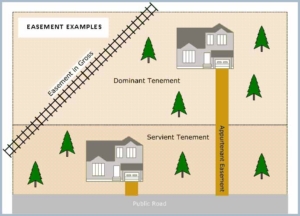In this article we will dig deeper into what easements are, how they are created and common types of easements. We will also break down the difference between appurtenant and in gross easements.
By definition, an easement is a legal right that allows the holder of the easement to use property that he/she does not own or possess for a specific limited purpose.

An easement does not allow the easement holder to occupy the land, or to exclude others from the land, unless they interfere with the easement holder’s use.
However, the possessor of the land may continue to use the easement and may exclude everyone except the easement holder from the land.
The parcel of land that benefits from the easement is the “dominant” tenement or estate, whereas the “servient” tenement or estate is the parcel of land that provides the easement.
Why Are Easements Created?
One of the rights of owning land is to be able to enter or leave it, but some parcels of land are isolated from public thoroughfares by other private properties. This is commonly when an easement is created.
There are also commercial easements. You may be wondering what’s the difference of a commercial easement to a normal easement?
A commercial easement is also known as a normal easement by many, the exception is it’s given for commercial purposes.
For example, an easement can allow work trucks of one business to pass through the property of another business, for the purposes of delivering goods and products.
Another example of a commercial easement is one party allowing a commercial entity to pass electrical infrastructure on the land to provide electricity.
When someone is granted an easement, the person is granted the legal right to use the property, but the legal title to the land itself remains with the owner of the land. Easements are created by express agreement by will, by deed or by implication.
In many cases, an owner creates an easement when selling a parcel of land or gives an easement to a buyer of the property to pass over the land because of convenience or necessity.
What Are 4 Types of Easements?
There are four common types of easements. They include easement by necessity, easement by prescription, easement by condemnation, and party easement.
1. Easement by Necessity: Briefly mentioned above, easement by necessity is created by a court order. This is because the dominant tenement owner has no other way of entering or leaving the property and must cross over the servient tenement.
2. Easement by Prescription: Created through long-term use, where the owner knew about the easement, but did not prevent its use, easement by prescription is created by implication. The length of time of use set by state law (typically 10-21 years) must have been continual and without the owner’s approval, but with the owner’s knowledge.
3. Easement by Condemnation: Created by eminent domain, typically for the greater good of the public, owners of the servient tenement must be compensated for providing the easement.
4. Party Easement: Created by written agreement between parties concerning a common boundary, such as a shared wall, a fence, or a driveway.
Easement Classifications: Appurtenant vs. In Gross
Easements are classified as either “appurtenant” or “in gross.”
Easements classified as “appurtenant” are said to “run with the land,” which means they are part of the formal ownership of the land. It is the right to use the adjoining property that transfers with the land. A title search by a prospective owner of the underlying property would reveal an easement appurtenant.
An easement “in gross” is a personal easement that does not transfer with the property – it is an individual interest to use the land that benefits a person or an organization. A title search would not show an easement in gross.
Sign Up For Our Newsletter
Please share this article if you found it insightful. Sign up for our newsletter here to receive our new articles in your inbox.






